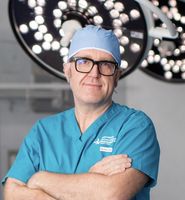Central Auckland, East Auckland, South Auckland, West Auckland, North Auckland > Private Hospitals & Specialists > MercyAscot >
MercyAscot Gynaecological Surgery
Private Surgical Service, Gynaecology
Consultants
Note: Please note below that some people are not available at all locations.
-

Mr Douglas Barclay
Gynaecological Surgeon
Available at Ascot Hospital, 90 Green Lane East, Remuera, Auckland
-

Dr Anna Bashford (Gynaecologist)
Gynaecological Surgeon
Available at Ascot Hospital, 90 Green Lane East, Remuera, Auckland
-

Dr Lynda Batcheler
Gynaecological Surgeon
Available at Ascot Hospital, 90 Green Lane East, Remuera, Auckland
-

Dr Carolyn Bilbrough
Gynaecological Surgeon
Available at Ascot Hospital, 90 Green Lane East, Remuera, Auckland
-

Dr Tin Chiu
Gynaecologist
Available at all locations.
-
Dr Prathima Chowdary
Gynaecologist
Available at Mercy Hospital, 98 Mountain Road, Epsom, Auckland
-

Dr Fiona Connell
Gynaecological Surgeon
Available at Mercy Hospital, 98 Mountain Road, Epsom, Auckland
-

Dr Praveen De Silva
Gynaecologist
Available at all locations.
-

Mr Mike East
Gynaecological Surgeon
Available at Ascot Hospital, 90 Green Lane East, Remuera, Auckland
-

Mr Simon Edmonds
Gynaecological Surgeon
Available at Ascot Hospital, 90 Green Lane East, Remuera, Auckland
-

Professor Cindy Farquhar
Gynaecological Surgeon
Available at Ascot Hospital, 90 Green Lane East, Remuera, Auckland
-

Dr Gillian Gibson
Gynaecological Surgeon
Available at Ascot Hospital, 90 Green Lane East, Remuera, Auckland
-

Dr Eva Hochstein
Gynaecologist
Available at all locations.
-

Professor Neil Johnson
Gynaecological Surgeon
Available at Ascot Hospital, 90 Green Lane East, Remuera, Auckland
-

Dr Simon Kelly
Gynaecological Surgeon
Available at Ascot Hospital, 90 Green Lane East, Remuera, Auckland
-

Dr Padmaja Koya
Gynaecological Surgeon
Available at Ascot Hospital, 90 Green Lane East, Remuera, Auckland
-

Dr Jye Lu
Gynaecological Surgeon
Available at Ascot Hospital, 90 Green Lane East, Remuera, Auckland
-

Dr Phill McChesney
Gynaecologist
Available at all locations.
-

Dr Katherine McKenzie
Gynaecological Surgeon
Available at Ascot Hospital, 90 Green Lane East, Remuera, Auckland
-

Dr Dionne Mills-Sillik
Gynaecologist
Available at all locations.
-

Dr Sunil Pillay
Gynaecologist
Available at all locations.
-

Dr Amelia Ryan
Gynaecologist
Available at all locations.
-

Dr Anil Sharma
Gynaecological Surgeon
Available at Ascot Hospital, 90 Green Lane East, Remuera, Auckland
-

Dr Martin Sowter
Gynaecological Surgeon
Available at Ascot Hospital, 90 Green Lane East, Remuera, Auckland
-

Dr Olivia Stuart
Gynaecological Surgeon
Available at Ascot Hospital, 90 Green Lane East, Remuera, Auckland
-

Dr Ai Ling Tan
Gynaecological Surgeon
Available at Ascot Hospital, 90 Green Lane East, Remuera, Auckland
-

Dr Anna-Marie Van Der Merwe
Gynaecological Surgeon
Available at Ascot Hospital, 90 Green Lane East, Remuera, Auckland
-

Dr Tze Wong
Gynaecologist
Available at all locations.
-

Dr Michael Wynn-Williams
Gynaecologist
Available at all locations.
Procedures / Treatments
Lletz (Large Loop Excision of the Transformation Zone) A thin wire loop that has an electrical current running through it is used to scrape abnormal cells from the cervix. Laser Treatment of the Cervix A laser beam (high energy light) is used to destroy abnormal cells of the cervix. Cone Biopsy of the Cervix A cone of tissue is surgically removed from the cervix for examination in the laboratory.
Lletz (Large Loop Excision of the Transformation Zone) A thin wire loop that has an electrical current running through it is used to scrape abnormal cells from the cervix. Laser Treatment of the Cervix A laser beam (high energy light) is used to destroy abnormal cells of the cervix. Cone Biopsy of the Cervix A cone of tissue is surgically removed from the cervix for examination in the laboratory.
Lletz (Large Loop Excision of the Transformation Zone)
A thin wire loop that has an electrical current running through it is used to scrape abnormal cells from the cervix.
Laser Treatment of the Cervix
A laser beam (high energy light) is used to destroy abnormal cells of the cervix.
Cone Biopsy of the Cervix
A cone of tissue is surgically removed from the cervix for examination in the laboratory.
A colposcopy is a detailed examination of the cervix (entrance to the uterus) with a specially lit microscope (colposcope). As with a cervical smear, an instrument called a speculum is inserted into the vagina, and then the colposcope is inserted with its light directed on the cervix. A specialist will perform a colposcopy if your cervical smear has shown abnormal or cancerous cells on the cervix. During the colposcopy further samples of tissue (biopsies) are usually removed and examined in the laboratory so the doctor can get a clearer idea of the extent of the abnormal cells.
A colposcopy is a detailed examination of the cervix (entrance to the uterus) with a specially lit microscope (colposcope). As with a cervical smear, an instrument called a speculum is inserted into the vagina, and then the colposcope is inserted with its light directed on the cervix. A specialist will perform a colposcopy if your cervical smear has shown abnormal or cancerous cells on the cervix. During the colposcopy further samples of tissue (biopsies) are usually removed and examined in the laboratory so the doctor can get a clearer idea of the extent of the abnormal cells.
A colposcopy is a detailed examination of the cervix (entrance to the uterus) with a specially lit microscope (colposcope). As with a cervical smear, an instrument called a speculum is inserted into the vagina, and then the colposcope is inserted with its light directed on the cervix.
A specialist will perform a colposcopy if your cervical smear has shown abnormal or cancerous cells on the cervix. During the colposcopy further samples of tissue (biopsies) are usually removed and examined in the laboratory so the doctor can get a clearer idea of the extent of the abnormal cells.
Incisions (cuts) are made in the abdomen (stomach) to allow access to your bladder. The vagina is lifted and attached to the pelvis wall, allowing the bladder neck to be supported, thus correcting urine leakage.
Incisions (cuts) are made in the abdomen (stomach) to allow access to your bladder. The vagina is lifted and attached to the pelvis wall, allowing the bladder neck to be supported, thus correcting urine leakage.
Incisions (cuts) are made in the abdomen (stomach) to allow access to your bladder. The vagina is lifted and attached to the pelvis wall, allowing the bladder neck to be supported, thus correcting urine leakage.
A long, thin tube with a tiny camera attached (cytoscope) is inserted into the urinary opening and through your urethra (the tube that carries urine from your bladder to the outside of your body) to your bladder. This allows the urologist to view any abnormalities in your lower urinary tract and, if necessary, take a small tissue sample to look at under the microscope (biopsy).
A long, thin tube with a tiny camera attached (cytoscope) is inserted into the urinary opening and through your urethra (the tube that carries urine from your bladder to the outside of your body) to your bladder. This allows the urologist to view any abnormalities in your lower urinary tract and, if necessary, take a small tissue sample to look at under the microscope (biopsy).
A long, thin tube with a tiny camera attached (cytoscope) is inserted into the urinary opening and through your urethra (the tube that carries urine from your bladder to the outside of your body) to your bladder. This allows the urologist to view any abnormalities in your lower urinary tract and, if necessary, take a small tissue sample to look at under the microscope (biopsy).
Metal dilators are inserted through your vagina and used to widen the opening to the uterus. A curette (an instrument with a flat metal loop at one end) is then used to scrape the lining of the uterus.
Metal dilators are inserted through your vagina and used to widen the opening to the uterus. A curette (an instrument with a flat metal loop at one end) is then used to scrape the lining of the uterus.
Metal dilators are inserted through your vagina and used to widen the opening to the uterus. A curette (an instrument with a flat metal loop at one end) is then used to scrape the lining of the uterus.
Laparoscopic: an incision (cut) is made near your navel (tummy button) and a thin tube with a tiny camera attached (laparoscope) is inserted, allowing the surgeon a view of the internal organs. If endometriosis is being treated, small instruments are introduced through several small cuts in the lower abdomen and endometrial tissue is destroyed using an electric current or laser beam. Abdominal (laparotomy): if endometriosis is very widespread, an incision is made in the abdomen, opening up the abdominal cavity so that the endometrial tissue can be removed.
Laparoscopic: an incision (cut) is made near your navel (tummy button) and a thin tube with a tiny camera attached (laparoscope) is inserted, allowing the surgeon a view of the internal organs. If endometriosis is being treated, small instruments are introduced through several small cuts in the lower abdomen and endometrial tissue is destroyed using an electric current or laser beam. Abdominal (laparotomy): if endometriosis is very widespread, an incision is made in the abdomen, opening up the abdominal cavity so that the endometrial tissue can be removed.
Laparoscopic: an incision (cut) is made near your navel (tummy button) and a thin tube with a tiny camera attached (laparoscope) is inserted, allowing the surgeon a view of the internal organs. If endometriosis is being treated, small instruments are introduced through several small cuts in the lower abdomen and endometrial tissue is destroyed using an electric current or laser beam.
Abdominal (laparotomy): if endometriosis is very widespread, an incision is made in the abdomen, opening up the abdominal cavity so that the endometrial tissue can be removed.
Abdominal: an incision (cut) is made in your the abdomen (stomach) and the uterus removed. Vaginal: an incision is made in your vagina and the uterus removed through the vagina. Laparoscopic: several small incisions are made in your abdomen and a thin tube with a tiny camera attached (laparoscope) inserted along with instruments that cut the connections of the uterus, allowing it to be removed through the vagina. Abdominal: an incision (cut) is made in your the abdomen (stomach) and the uterus removed. Vaginal: an incision is made in your vagina and the uterus removed through the vagina. Laparoscopic: several small incisions are made in your abdomen and a thin tube with a tiny camera attached (laparoscope) inserted along with instruments that cut the connections of the uterus, allowing it to be removed through the vagina.
Abdominal: an incision (cut) is made in your the abdomen (stomach) and the uterus removed. Vaginal: an incision is made in your vagina and the uterus removed through the vagina. Laparoscopic: several small incisions are made in your abdomen and a thin tube with a tiny camera attached (laparoscope) inserted along with instruments that cut the connections of the uterus, allowing it to be removed through the vagina. Abdominal: an incision (cut) is made in your the abdomen (stomach) and the uterus removed. Vaginal: an incision is made in your vagina and the uterus removed through the vagina. Laparoscopic: several small incisions are made in your abdomen and a thin tube with a tiny camera attached (laparoscope) inserted along with instruments that cut the connections of the uterus, allowing it to be removed through the vagina.
Abdominal: an incision (cut) is made in your the abdomen (stomach) and the uterus removed.
Vaginal: an incision is made in your vagina and the uterus removed through the vagina.
Laparoscopic: several small incisions are made in your abdomen and a thin tube with a tiny camera attached (laparoscope) inserted along with instruments that cut the connections of the uterus, allowing it to be removed through the vagina.
A speculum is inserted into your vagina, as for a cervical smear, and a long, thin tube with a tiny camera attached (hysteroscope) is placed into the vagina and moved through into the uterus. This allows the surgeon to see inside the uterus and may, in some cases, show the reason for conditions such as infertility or pelvic pain. A hysteroscope may also be used to remove fibroids or polyps or to take a biopsy (small sample of tissue) for examination in the laboratory.
A speculum is inserted into your vagina, as for a cervical smear, and a long, thin tube with a tiny camera attached (hysteroscope) is placed into the vagina and moved through into the uterus. This allows the surgeon to see inside the uterus and may, in some cases, show the reason for conditions such as infertility or pelvic pain. A hysteroscope may also be used to remove fibroids or polyps or to take a biopsy (small sample of tissue) for examination in the laboratory.
A speculum is inserted into your vagina, as for a cervical smear, and a long, thin tube with a tiny camera attached (hysteroscope) is placed into the vagina and moved through into the uterus. This allows the surgeon to see inside the uterus and may, in some cases, show the reason for conditions such as infertility or pelvic pain. A hysteroscope may also be used to remove fibroids or polyps or to take a biopsy (small sample of tissue) for examination in the laboratory.
Anterior: an incision (cut) is made in your navel (tummy button) and several small cuts in the abdomen (stomach). A thin telescopic instrument (laparoscope) and several small instruments are inserted into the cuts and used to tighten up the front wall of the vagina to repair a cystocele (bulging of the bladder into the vaginal wall). Posterior: an incision is made in your navel and several small cuts in the abdomen. A laparoscope and several small instruments are inserted into the cuts and used to tighten up the back wall of the vagina to repair a rectocele (bulging of the rectum into the vaginal wall).
Anterior: an incision (cut) is made in your navel (tummy button) and several small cuts in the abdomen (stomach). A thin telescopic instrument (laparoscope) and several small instruments are inserted into the cuts and used to tighten up the front wall of the vagina to repair a cystocele (bulging of the bladder into the vaginal wall). Posterior: an incision is made in your navel and several small cuts in the abdomen. A laparoscope and several small instruments are inserted into the cuts and used to tighten up the back wall of the vagina to repair a rectocele (bulging of the rectum into the vaginal wall).
Anterior: an incision (cut) is made in your navel (tummy button) and several small cuts in the abdomen (stomach). A thin telescopic instrument (laparoscope) and several small instruments are inserted into the cuts and used to tighten up the front wall of the vagina to repair a cystocele (bulging of the bladder into the vaginal wall).
Posterior: an incision is made in your navel and several small cuts in the abdomen. A laparoscope and several small instruments are inserted into the cuts and used to tighten up the back wall of the vagina to repair a rectocele (bulging of the rectum into the vaginal wall).
Laparoscopic: an incision (cut) is made in your navel (tummy button) and several small cuts in the abdomen (stomach). A thin telescopic instrument (laparoscope) and several small instruments are inserted into the cuts and moved through into the uterus allowing the surgeon to view the fibroids. Small fibroids can then be removed either by introducing small surgical tools to cut them away or by vaporising them with a laser or electric current. For large fibroids, an incision is made across your abdomen and the fibroids are cut out of the uterus. Hysteroscopic: a speculum is inserted into your vagina, as for a pap smear, and a long, thin tube with a tiny camera attached (hysteroscope) is placed into the vagina and moved through into the uterus. This allows the surgeon to see inside the uterus and remove the fibroids.
Laparoscopic: an incision (cut) is made in your navel (tummy button) and several small cuts in the abdomen (stomach). A thin telescopic instrument (laparoscope) and several small instruments are inserted into the cuts and moved through into the uterus allowing the surgeon to view the fibroids. Small fibroids can then be removed either by introducing small surgical tools to cut them away or by vaporising them with a laser or electric current. For large fibroids, an incision is made across your abdomen and the fibroids are cut out of the uterus. Hysteroscopic: a speculum is inserted into your vagina, as for a pap smear, and a long, thin tube with a tiny camera attached (hysteroscope) is placed into the vagina and moved through into the uterus. This allows the surgeon to see inside the uterus and remove the fibroids.
Laparoscopic: an incision (cut) is made in your navel (tummy button) and several small cuts in the abdomen (stomach). A thin telescopic instrument (laparoscope) and several small instruments are inserted into the cuts and moved through into the uterus allowing the surgeon to view the fibroids. Small fibroids can then be removed either by introducing small surgical tools to cut them away or by vaporising them with a laser or electric current. For large fibroids, an incision is made across your abdomen and the fibroids are cut out of the uterus.
Hysteroscopic: a speculum is inserted into your vagina, as for a pap smear, and a long, thin tube with a tiny camera attached (hysteroscope) is placed into the vagina and moved through into the uterus. This allows the surgeon to see inside the uterus and remove the fibroids.
Laparascopic: several small incisions (cuts) are made in your abdomen (stomach) and a thin tube with a tiny camera attached (laparoscope) inserted, allowing the surgeon a view of the ovaries. Small surgical instruments are introduced through the other cuts and are used to remove the ovary and tie off the fallopian tube. Abdominal: an incision is made in the abdomen, the ovary is surgically removed and the fallopian tube tied off. Laparascopic: several small incisions (cuts) are made in your abdomen (stomach) and a thin tube with a tiny camera attached (laparoscope) inserted, allowing the surgeon a view of the ovaries. Small surgical instruments are introduced through the other cuts and are used to remove the ovary and tie off the fallopian tube. Abdominal: an incision is made in the abdomen, the ovary is surgically removed and the fallopian tube tied off.
Laparascopic: several small incisions (cuts) are made in your abdomen (stomach) and a thin tube with a tiny camera attached (laparoscope) inserted, allowing the surgeon a view of the ovaries. Small surgical instruments are introduced through the other cuts and are used to remove the ovary and tie off the fallopian tube. Abdominal: an incision is made in the abdomen, the ovary is surgically removed and the fallopian tube tied off. Laparascopic: several small incisions (cuts) are made in your abdomen (stomach) and a thin tube with a tiny camera attached (laparoscope) inserted, allowing the surgeon a view of the ovaries. Small surgical instruments are introduced through the other cuts and are used to remove the ovary and tie off the fallopian tube. Abdominal: an incision is made in the abdomen, the ovary is surgically removed and the fallopian tube tied off.
Laparascopic: several small incisions (cuts) are made in your abdomen (stomach) and a thin tube with a tiny camera attached (laparoscope) inserted, allowing the surgeon a view of the ovaries. Small surgical instruments are introduced through the other cuts and are used to remove the ovary and tie off the fallopian tube.
Abdominal: an incision is made in the abdomen, the ovary is surgically removed and the fallopian tube tied off.
Several small incisions (cuts) are made in your abdomen (stomach) and a thin tube with a tiny camera attached (laparoscope) inserted, allowing the surgeon a view of your ovaries. Small instruments are inserted through the cuts and into the ovaries, where they remove the cysts.
Several small incisions (cuts) are made in your abdomen (stomach) and a thin tube with a tiny camera attached (laparoscope) inserted, allowing the surgeon a view of your ovaries. Small instruments are inserted through the cuts and into the ovaries, where they remove the cysts.
Several small incisions (cuts) are made in your abdomen (stomach) and a thin tube with a tiny camera attached (laparoscope) inserted, allowing the surgeon a view of your ovaries. Small instruments are inserted through the cuts and into the ovaries, where they remove the cysts.
An incision (cut) is made in your navel (tummy button) and several small cuts in the abdomen (stomach). A thin telescopic instrument (laparoscope) is inserted through your navel, allowing the surgeon a view of the pelvic floor. Small instruments are inserted into the cuts that can lift the prolapsed or sagging organs back into position and reattach them.
An incision (cut) is made in your navel (tummy button) and several small cuts in the abdomen (stomach). A thin telescopic instrument (laparoscope) is inserted through your navel, allowing the surgeon a view of the pelvic floor. Small instruments are inserted into the cuts that can lift the prolapsed or sagging organs back into position and reattach them.
An incision (cut) is made in your navel (tummy button) and several small cuts in the abdomen (stomach). A thin telescopic instrument (laparoscope) is inserted through your navel, allowing the surgeon a view of the pelvic floor. Small instruments are inserted into the cuts that can lift the prolapsed or sagging organs back into position and reattach them.
Laparoscopic: several small incisions (cuts) are made in your abdomen (stomach) and a thin tube with a tiny camera attached (laparoscope) inserted, allowing the surgeon a view of your fallopian tubes. Small surgical instruments are introduced through the other cuts and are used to remove part or all of the fallopian tube. Abdominal (laparotomy): an incision is made in your abdomen and part or all of the fallopian tube is removed.
Laparoscopic: several small incisions (cuts) are made in your abdomen (stomach) and a thin tube with a tiny camera attached (laparoscope) inserted, allowing the surgeon a view of your fallopian tubes. Small surgical instruments are introduced through the other cuts and are used to remove part or all of the fallopian tube. Abdominal (laparotomy): an incision is made in your abdomen and part or all of the fallopian tube is removed.
Laparoscopic: several small incisions (cuts) are made in your abdomen (stomach) and a thin tube with a tiny camera attached (laparoscope) inserted, allowing the surgeon a view of your fallopian tubes. Small surgical instruments are introduced through the other cuts and are used to remove part or all of the fallopian tube.
Abdominal (laparotomy): an incision is made in your abdomen and part or all of the fallopian tube is removed.
A sample of tissue (biopsy) is surgically removed from a lesion (area of damaged tissue) on your vulva. If the lesion is cut out completely, the procedure is called an excision.
A sample of tissue (biopsy) is surgically removed from a lesion (area of damaged tissue) on your vulva. If the lesion is cut out completely, the procedure is called an excision.
A sample of tissue (biopsy) is surgically removed from a lesion (area of damaged tissue) on your vulva. If the lesion is cut out completely, the procedure is called an excision.
Disability Assistance
Wheelchair access, Mobility parking space
Parking
Mobility parking and wheelchair access are available. Click on the links for details at:
Mercy Hospital
Ascot Hospital
Website
Contact Details
Mercy Hospital, 98 Mountain Road, Epsom, Auckland
Central Auckland
Website
(09) 623 5700
(09) 623 5701
Fax (09) 623 5702 consumer services
Street Address
98 Mountain Road
Epsom
Auckland
Postal Address
PO Box 9911
Newmarket
Auckland 1149
Ascot Hospital, 90 Green Lane East, Remuera, Auckland
Central Auckland
-
Phone
(09) 520 9500
-
Fax
(09) 520 9501
Website
Was this page helpful?
This page was last updated at 2:57PM on January 28, 2025. This information is reviewed and edited by MercyAscot Gynaecological Surgery.


